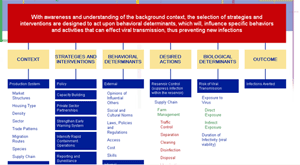
View the Conceptual Framework
Page | Brochure (PDF)
As a result of three years of on-the-ground behavior change communication work and research on H5N1 in over 19 countries, AED pooled its research and other lessons learned and designed a communication conceptual framework that can be used to respond to avian flu outbreaks and other epizootics. An interactive website is forthcoming to showcase the "Communication Conceptual Framework for AHI and Other Emerging Infectious Diseases."
The framework is based on a six-part premise: 1) With awareness and understanding of the background context, 2) the selection of strategies and interventions are designed to act upon behavioral determinants, which in turn will 3) act upon behavioral determinants, which in turn will, 4) influence specific behaviors and activities, 5) that can affect viral transmission, thus 6) preventing new infections. In each step, users of the framework can select an array of choices for the context (e.g., production systems, political and organizational structure, endemicity, socioeconomic factors); strategies and interventions (e.g., communication, policy, capacity building, private sector partnerships, reporting and surveillance); behavioral determinants (e.g., external or internal); desired actions (e.g., reservoir control, blocking actions, preventing infection within the target group); biological determinants (e.g., risk of viral transmission); and outcomes (e.g., infections averted).
This framework can be used in a variety of settings - urban and rural, developing and industry settings - and applied to avian and human influenzas as well as other emerging infectious diseases. As we move into new areas (emerging infectious diseases and possibly malaria and dengue in Thailand), new opportunities to test and further develop the Conceptual Framework are in the offing.
| 
